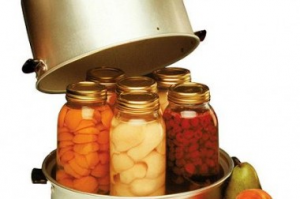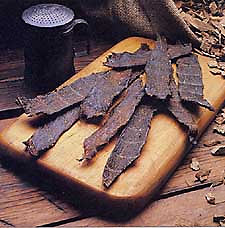 The University of Wisconsin issued recommendations a few years ago for safely using an atmospheric steam canner for home canning of naturally acid or acidified foods. The atmospheric steam canner has some advantages over a boiling water canner for processing high acid foods. Research recommendations indicated that naturally acid foods, such as peaches, apples, jams and jellies, or acidified foods, such as pickles or salsa, may be safely canned in a steam canner as long as a recipe tested for a boiling water canner is used and some guidelines were followed.
The University of Wisconsin issued recommendations a few years ago for safely using an atmospheric steam canner for home canning of naturally acid or acidified foods. The atmospheric steam canner has some advantages over a boiling water canner for processing high acid foods. Research recommendations indicated that naturally acid foods, such as peaches, apples, jams and jellies, or acidified foods, such as pickles or salsa, may be safely canned in a steam canner as long as a recipe tested for a boiling water canner is used and some guidelines were followed.
What does it mean to use a ‘tested recipe‘ when canning with an atmospheric steam canner? Or more generally, what does a ‘tested recipe’ mean for home food preservation?
A tested recipe is one where we have data, or prior knowledge, that supports food safety. The data that we may need comes from a laboratory and, in the case of home canning, involves measuring the temperature of product inside the jar (to make sure the food is heated sufficiently at all parts within the jar). When UW tested the atmospheric steam canner against a boiling water canner we also had to measure temperature at various places within the canner (not just in the food) so that we could understand how heat was being transferred into the food in the jar. We used mathematical models to understand heat penetration and estimate pathogen death in foods processed in a steam canner. When my laboratory researched the safety of making beef jerky at home, our goal was to understand how foodborne pathogens that might be on raw meat would behave when drying meat in a home-style dehydrator (instead of  a large commercial smokehouse). This research involved adding pathogens to meat and seeing how they survived during heating, using equipment and processes that anyone at home might use. Similarly, this research led to recommendations for consumers for safely making beef or venison jerky in a home dehydrator.
a large commercial smokehouse). This research involved adding pathogens to meat and seeing how they survived during heating, using equipment and processes that anyone at home might use. Similarly, this research led to recommendations for consumers for safely making beef or venison jerky in a home dehydrator.
Because of the complexity of gathering the data needed to prove safety, laboratories doing the research to support safe home food preservation methods are on university campuses, such as the work that has been done by the National Center for Home Food Preservation at the University of Georgia. The National Center periodically updates the USDA Complete Guide to Home Canning and conducts separate research in support of safe home food preservation. Our research on atmospheric steam canners was conducted with support from the National Center.
Sources of research tested recipes include the USDA Complete Guide to Home Canning, additional materials from the National Center and, in Wisconsin, Extension Safe Food Preservation resources. Websites such as Pinterest, celebrity chefs such as Martha Stewart, and cookbooks, magazines, and newspaper articles can not be counted on to share tested recipes. Extension recommends a limited number of home food preservation resources: the USDA Complete Guide to Home Canning, the National Center website materials, and Wisconsin Safe Food Preservation series publications. Encourage consumers to use these resources. Think spring and safe preserving! Barb



